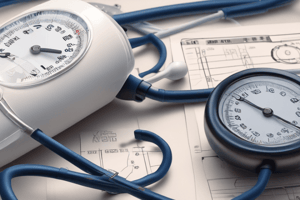Podcast
Questions and Answers
What does diastolic pressure measure?
What does diastolic pressure measure?
- Pressure after contraction and before the next contraction (correct)
- Pressure during heart contraction
- Average blood pressure over time
- Pressure within the arteries during rest
What happens to the baroreceptors when there is a decrease in arterial pressure?
What happens to the baroreceptors when there is a decrease in arterial pressure?
- They decrease the stretch on the walls of the carotid sinus. (correct)
- They maintain a constant level of firing regardless of pressure.
- They increase the firing rate of the carotid sinus nerve.
- They stimulate the sympathetic nervous system to lower heart rate.
What primary function do baroreceptors serve in relation to blood pressure?
What primary function do baroreceptors serve in relation to blood pressure?
- They enhance sympathetic nervous system activity.
- They regulate blood pressure over long durations.
- They provide feedback to the autonomic nervous system. (correct)
- They detect increases in heart rate.
Which device is used for manual measurement of blood pressure?
Which device is used for manual measurement of blood pressure?
What is the primary mechanism for short-term regulation of blood pressure?
What is the primary mechanism for short-term regulation of blood pressure?
What neural response is triggered when baroreceptors detect decreased arterial pressure?
What neural response is triggered when baroreceptors detect decreased arterial pressure?
Why can baroreceptors not regulate blood pressure over the long term?
Why can baroreceptors not regulate blood pressure over the long term?
Where are baroreceptors located that are responsible for detecting changes in blood pressure?
Where are baroreceptors located that are responsible for detecting changes in blood pressure?
What percentage of patients might experience inaccuracy with a digital blood pressure monitor?
What percentage of patients might experience inaccuracy with a digital blood pressure monitor?
What is the typical set point for mean arterial pressure in the vasomotor centre?
What is the typical set point for mean arterial pressure in the vasomotor centre?
Flashcards are hidden until you start studying
Study Notes
Blood Pressure Measurement
- Diastolic pressure is the second number in blood pressure readings, indicating pressure after heart contraction and before the next contraction (80 mmHg example).
- Measurement methods include:
- Manual: Using an aneroid or mercury sphygmomanometer.
- Digital: Automated monitors using oscillometric sphygmomanometers, which may be inaccurate in 5-15% of patients.
- Invasive: Direct measurement of arterial pressure through cannulation of arteries (typically radial), using non-compressible tubing with heparinized saline.
Regulation of Arterial Pressure
- Regulation mechanisms include:
- Short-Term (Neurally Mediated Baroreceptor Mechanism): Rapid adjustments by the autonomic nervous system (ANS).
- Long-Term (Hormonal Regulation): Involves the renin-angiotensin-aldosterone system (RAAS).
Short-Term Blood Pressure Regulation
- Baroreceptors in the aortic arch and carotid sinus detect changes in blood pressure via stretch receptors.
- Increased arterial pressure triggers negative feedback to the ANS, decreasing heart rate and contractility, leading to lowered blood pressure.
- Decreased arterial pressure causes sympathetic stimulation, increasing heart rate and contractility to raise blood pressure.
- The baroreceptor reflex offers minute-to-minute regulation of blood pressure.
Baroreceptor Reflex Mechanism
- Decrease in Arterial Pressure:
- Decreased stretch on carotid sinus walls reduces signals sent to the CNS via Hering's nerve (a branch of cranial nerve IX).
- If mean arterial pressure drops below 100 mmHg:
- Decreased parasympathetic outflow and increased sympathetic outflow raise blood pressure by:
- Increasing heart rate (decreased vagal tone).
- Enhancing contractility and stroke volume.
- Promoting vasoconstriction of arterioles and veins.
- Increasing total peripheral resistance (TPR) and venous return, increasing cardiac output through the Frank–Starling mechanism.
- Decreased parasympathetic outflow and increased sympathetic outflow raise blood pressure by:
- Example: Valsalva maneuver tests baroreceptor function; a significant heart rate increase indicates intact reflex mechanism.
Long-Term Blood Pressure Regulation
- Key physiological mechanisms include:
- Renin-Angiotensin-Aldosterone System (RAAS): Controls blood pressure by regulating fluid balance.
- Vasopressin (ADH): Promotes water retention.
- Atrial Natriuretic Peptide (ANP): Promotes sodium excretion.
Renin-Angiotensin-Aldosterone System (RAAS)
- Renin is released from juxtaglomerular cells in response to:
- Sympathetic stimulation.
- Reduced sodium delivery to the distal convoluted tubule.
- Decreased renal blood flow.
- Renin converts angiotensinogen (from the liver) to angiotensin I, which converts to angiotensin II (vasoconstrictor) via ACE.
- Angiotensin II promotes sodium reabsorption and aldosterone secretion, leading to water retention and increased blood volume and pressure.
- ACE inhibitors and angiotensin receptor blockers are used to lower blood pressure.
Clinical Relevance - Hypertension
- Hypertension is a sustained increase in blood pressure and can be primary (unknown cause) or secondary to conditions like chronic renal disease.
- It causes vascular damage, leading to atherosclerosis, thromboembolism (risk of MI or stroke), and aneurysms, while also increasing the heart's afterload.
Studying That Suits You
Use AI to generate personalized quizzes and flashcards to suit your learning preferences.




